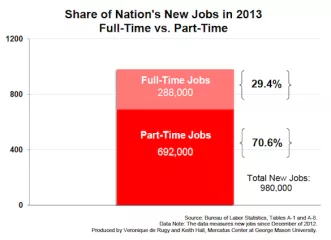- | Financial Markets Financial Markets
- | Expert Commentary Expert Commentary
- |
A Dearth of Investment in Young Workers
Tyler Cowen at The New York Times.
One of the most troubling features of the slow economic recovery is that it has largely bypassed young people. This doesn’t bode well for the future of the American economy.
For Americans aged 16 to 24 who aren’t enrolled in school, the employment picture is grim. Only 36 percent are working full time, down 10 percentage points from 2007. Longer term, the overall labor-force participation rate for that age group has dropped 20 percentage points for men and 14 points for women since 1989.
This lack of jobs will damage the long-term careers of a big chunk of the next working generation. Not working after you finish school very often means missing out on developing the skills and habits that will serve you well later on. The current employment numbers are therefore like a telescope into the future labor market: a 23-year-old who is working part time as a dog walker, yoga instructor or retail clerk may be having fun, but perhaps will receive fewer promotions as a 47-year-old.
One culprit in this situation may be the higher minimum wage enacted in 2009, but the root causes run much deeper.
Employers appear to be more risk-averse, more concerned about overhead costs and less willing to invest in developing young workers’ skills. And that seems true across a wide variety of sectors.
In the legal profession, for instance, there is less interest in hiring junior associates and grooming them for partner status. Colleges and universities are often more interested in hiring adjuncts than tenure-track young faculty members. And publishing houses, instead of providing a big advance upfront and investing in young authors over a series of books, now expect many writers to earn their share of a book’s revenue through royalties.
If we consider how many jobs are being advertised, without asking whether they are being filled, the labor market seems to be booming. If we measure labor market progress in terms of actual hiring, however, it’s clear that the economy is recovering slowly. Employers appear to be looking around for workers but then holding out for the very best candidates, and, if need be, making do with few new hires or none at all.
These are signs of a world where next year’s business income is less certain, and many employers take greater care to keep weaker workers off the corporate team. Some employers would rather spend on information technology than hire the wrong workers. Some prefer to invest in the developing world with its longer work hours and lower wages. I outline these processes in my forthcoming book, “Average Is Over: Powering America Beyond the Age of the Great Stagnation” (Dutton Adult).
Young people who are hired often fail to find desirable, high-paying jobs. If we consider four-year college graduates only, average starting salaries, inflation-adjusted, were higher in 2000 than they are today, a decline that started well before the financial crisis. On balance, though, college remains “a good deal,” in part because wages for nongraduates have fallen even more than those for graduates. That is hardly a reassuring sign for the broader economy.
These developments put economic pressure on higher education. If it’s harder to get a good and lucrative job after college, why should students pay ever-rising tuition rates? College doesn’t always prepare students very well for the work force, and most graduates don’t enjoy the relatively rosy job prospects of computer science and engineering majors.
As tuition increases slow because of a sluggish labor market, colleges will have to change, making their offerings more relevant. But significant improvements may be hard to come by. Slow-growing or even shrinking revenue will strip colleges of financial resources, and they may suddenly have to focus on managing a decline rather than building for a more innovative future.
Policy changes to bolster economic growth and employment, whether by simplifying the tax code, repealing some occupational licensing, bringing more rigor to K-12 schooling or accrediting cheaper online education, may help reverse or curb these trends. But to focus on policy alone is to miss the gravity of the situation.
Falling wages for new entrants to the job market suggest that a sizable chunk of the American labor force may never achieve middle-class wages in a relatively secure full-time job. And many young people don’t want to take physically demanding jobs, which are often filled by immigrants. Some young people are breaking out of these traps by starting new Internet or service-based businesses, in lieu of looking for traditional employment. But others end up in part-time, temporary or low-quality jobs, biding their time and hoping that something changes.
We may not like what the market is indicating here, but it would be a mistake to shoot the messenger — namely, the market itself. Businesses are measuring value more accurately and choosing more cautiously, and though that raises overall productivity, it isn’t good for all workers. Many face the burden of meeting the standards of a more demanding world, and not all are succeeding at that task. It’s a problem that won’t be solved by any kind of quick fix.
